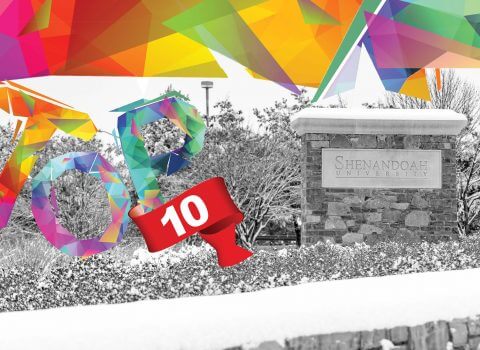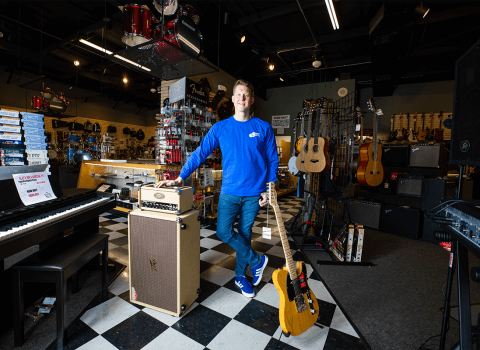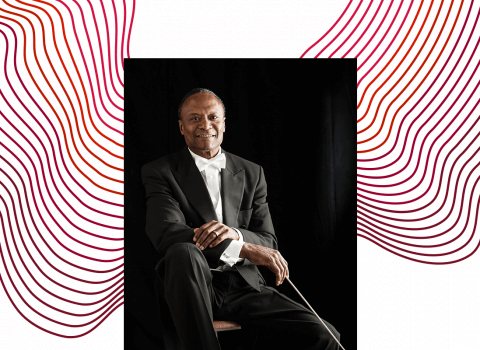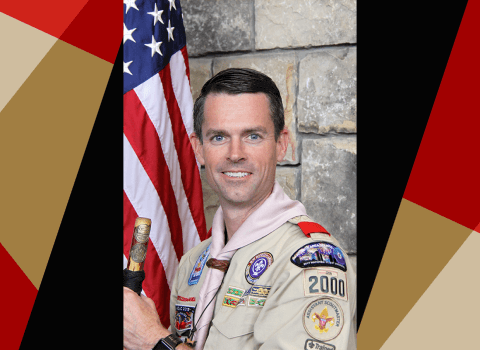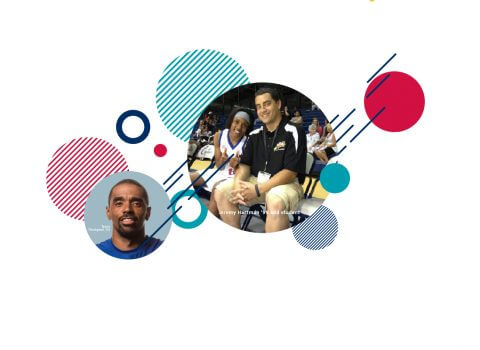Anticipation builds as preliminary site work ensues near Shentel Stadium for the construction of a new indoor athletics and events center. Reflecting on the exciting new possibilities this facility will create for our community, student-athletes, former players and coaches describe how involvement with Shenandoah athletics changed their lives.
The multipurpose facility, scheduled to be completed in late fall/winter 2017, and located next to Shentel Stadium, is a space designed for a diverse array of varsity competitions and practice, including indoor track, basketball and volleyball. With retractable seating for 1,600, the new center will also encompass a 200-meter, six-lane competition track with eight sprint lanes, throwing cages, sand pit and pole-vaulting areas. Additional features are home and away locker room facilities, a concession stand and satellite athletic training areas. The state-of-the-art structure will also be available for community use. As a large events space, it will seat approximately 5,000 theatre-style or nearly 1,000 for a sit-down dinner. It is poised to be in the top tier of indoor facilities in the Old Dominion Athletic Conference (ODAC).
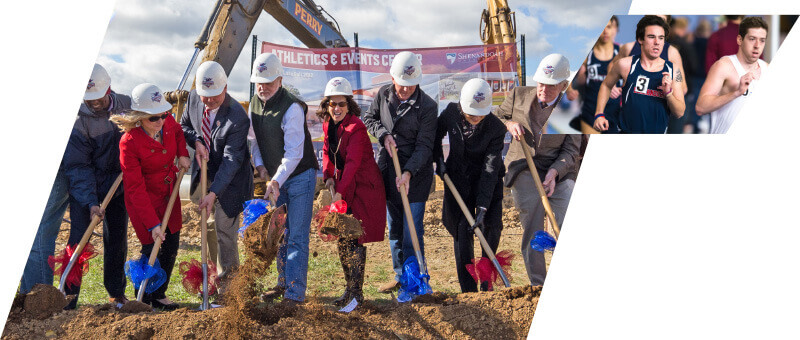
“The athletics and events center will serve multiple audiences,” says University President Tracy Fitzsimmons, Ph.D. “First and foremost it will serve our student-athletes. We want them to have the very best. It’s so much a part of their lives. We believe we already have the best Division III coaches here. We need to have the best facilities, as well.
“This will also be a very important building for all of the Northern Valley,” continues Dr. Fitzsimmons. “It will be the largest indoor space between Harrisonburg, Virginia, up to Harrisburg, Pennsylvania. I’m very excited for what this facility will bring to the area. We serve our students, but we also serve our community. This building will help us do that at even a higher level.”
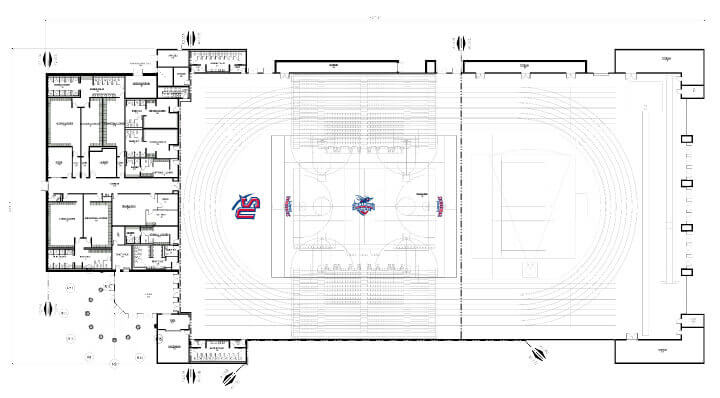
Shenandoah Athletic Director Doug Zipp adds, “This is going to completely change the way we do athletics for our student athletes. It’s going to be a place we can be so very proud of, not only athletically, but from a university standpoint. It’s a multipurpose facility that is going to serve the needs of our 480 student-athletes all year round — rain and shine.
“Throughout our history, student-athletes have given so much to the university,” says Zipp. “They have brought it recognition. They have brought quality citizenship. They have brought diversity and different perspectives. They have brought their inspiration and passion. They established a foundation upon which we have built and are continuing to build. The new athletic and events center would never exist if not for them. My mantra has been, ‘We are 21 sports and one team.” And every student-athlete who has ever competed at SU is a part of that team.”
Breaking Ground
The October 2016, groundbreaking of Shenandoah University’s 77,000-square-foot indoor athletic and events center begins a transformational new era for the university, its athletic program, and present and future student-athletes, who will consecrate it with their dreams and aspirations.
Phil Dixon ’96, Basketball, Hall of Fame
I’m from Baltimore, Maryland. An assistant coach contacted me on the phone and recruited me. I didn’t have a whole lot of interest at first. But we had a good conversation, so I went down to Shenandoah for a visit.
Nobody in my family on my mom’s side had ever gone to college. So I was a little nervous…but the small setting was perfect for me.
The basketball team was just like a family. We went everywhere together. We ate together. We walked to class together. We were together all day long on campus. In our basketball sweat suits we all looked like twins.
Shenandoah basketball had already had some success when I got there. But the year before I came, they weren’t that good. And my first year, we weren’t that good. We had a young team. But we were building a core. The chemistry was there. We were complete gym rats just trying to get better. The whole time I was at Shenandoah, along with our classes and studying, it was all about basketball. Our senior year, we went to the NCAA tournament.
The atmosphere was just amazing. When the Shenandoah Hornets played on Friday and Saturday nights, you had the president of the school there. You had the professors there. You had the students there. You had the baseball team and the soccer team. You had people from the town. The gym was hot, and we were rocking and rolling. I couldn’t have asked for a better situation at a small school. To me, it felt like a big-time school.
Coaches Dave Dutton and Rob Harris set the culture. Coach Dutton’s presence was all around the campus. When he walked in a room, he commanded it. And he demanded the respect of all the players and staff members.
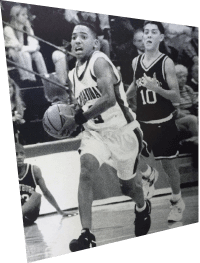 The way Coach Dutton ran the program, we felt like rock stars. It was Division III, but you thought you were in Division I. It was first class. And that’s what I would have to say about him. He was first class.
The way Coach Dutton ran the program, we felt like rock stars. It was Division III, but you thought you were in Division I. It was first class. And that’s what I would have to say about him. He was first class.
The diversity of Shenandoah University was big for me. Baltimore is a predominantly black city, so most of my friends were black. Coming to Shenandoah was an eye-opener. It was a culture shock. It was not the city life. And it opened my eyes. It built my character. It allowed me to feel comfortable in any setting — black, white, whatever. At Shenandoah, it was my first time being around a music student, or a soccer player or a lacrosse player. Getting to college was like, “What the heck is this?” But with the support of Coach Dutton and Coach Harris, I was able to make the transition.
Everybody knows about my success on the basketball court. But my own highlight was getting my degree. It’s what I’m most proud of. The growth of the school makes me happy. I just wish I could play in the new athletic center!
Phil Dixon, 42, is a sergeant in the Baltimore Police Force.
Jaclyn Mohlmann ’13 ’15, Cross Country/Track & Field
I never competed in outdoor track & field while I was in high school. I played soccer and did indoor track. I loved it.
After high school, I first went to Lynchburg College. I didn’t run for them at all. By the end of my sophomore year, I realized I wasn’t happy there and transferred to Shenandoah. It turns out that Shenandoah was just perfect for me.
When I first got there, I contacted coach [Andy] Marrocco and he let me join the team. I ran for him my junior and senior year, then I stayed to get my master’s, which took two years. That’s when I finished my four-year eligibility.
My first two years in the track program, I just wanted to be on the team. I wanted to make friends. My goal was to be as successful as I could, but I more or less just wanted to be a part of something. It wasn’t until about two months before I graduated with my bachelor’s that I started training for the multis — the heptathlon. My coach and I sat down and started doing some numbers, and we realized I might be a good multi. So I did it. I went through the last meet, and it turns out I was three people away from going to the nationals in the multis. It took me about ten seconds for me to be, like, ‘I’m going back for my master’s. I’m going to keep doing school so I can compete in track.’ And I did.
The second two years of my track program, there was a lot more passion out of me, a lot more drive. I was focused. It wasn’t so much about just participation, it was about accomplishment. At that point, that’s when I really started to make some goals for myself in track.
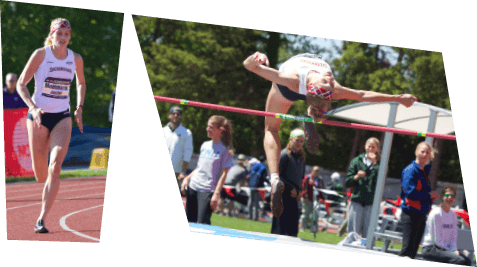
All four years at Shenandoah, I grew as an individual, as a person, physically, mentally, [and] emotionally. I grew so much in those years. Being a student-athlete, I felt like I improved my time management skills, my self-discipline, my social skills, my drive, motivation and goal setting. l reached those goals. I came in as a nobody and left as one of the top athletes in the nation. The fact that Shenandoah was a small program was not a negative. It was a positive. You got more attention — from the coaches, from the professors. I needed that.
Jaclyn Mohlmannt is an assistant track and field coach at Randolph College in Lynchburg, Virginia.
Jake Loew, ’17 Baseball
I grew up playing baseball in upstate New York, and I really wanted to play at the next level. I looked at a lot of schools down in Florida, and when it came time to make that decision, I was a little freaked out. Then I visited Shenandoah and really liked it. The atmosphere was welcoming, and the baseball program is top-notch. So I decided to come here.
The coaches here encourage you to be a student-athlete, not just to focus on your sport. I’m in the business program, and that’s one of the main reasons I came here. I thought it was definitely where I needed to get my education for life after college baseball.
We’re in Division III, and it has surpassed my expectations. People say, “Oh, Division III, it’s not that important.” But Shenandoah runs like a Division I program. The way we do things, the way we warm up, the way we travel, is almost like a professional baseball team.
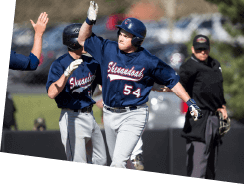
Our team is good. Everybody is really supportive. Since I’ve been here, we’ve won the regular ODAC championship all three years. We’ve gone to regionals seven out of the last eight years, three of them while I was here at Shenandoah. The new athletic center is definitely needed. Our current gym is great, but you’ll see at basketball games the place is packed full. At volleyball games the volleyball hits the ceiling. So it’s definitely needed. Having a big athletic center will draw other athletes and prospective students to the school.
Laura Johnson Sirbaugh ’85 Basketball (Volleyball, Softball), Hall of Fame
I grew up in Winchester. I was all set to go to West Virginia University, but my parents put the brakes on that.
I played sports throughout high school, and my mom and dad knew that if I went to West Virginia, I wasn’t going to be doing that. They wanted to see me continue to play. So they said, “Try out Shenandoah and figure out what you ultimately want to do.” So that’s how I came to go to SU. It worked out very well for me. Parents know best.
I played basketball, volleyball and softball, but I was most successful in basketball. Back then the athletic department was relatively small. My first two years we were not NCAA. By my junior year, Shenandoah moved into the NCAA Division III.
Recruiting was a challenge. A lot of times we got students right out of the dorms to fill the teams. Some were at Shenandoah for the conservatory and that was always a concern — if they hurt their fingers or their hands. The coaching staff was very small, and the coaches managed multiple sports. We had very strong teams, though. We had some good players. We moved around a lot in conferences those first three years, and we did a lot of travelling. It was fun as an athlete to go to different places.
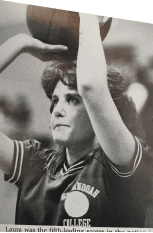 The highlight for me was standing out like I did at a small school like Shenandoah. I had graduated from high school in a class of 500, and it was pretty easy to get lost in the crowd. I had always participated in sports in high school, but it wasn’t until I hit Shenandoah and its small school environment, that I really excelled. I put in the time, effort and practice, and it paid off.
The highlight for me was standing out like I did at a small school like Shenandoah. I had graduated from high school in a class of 500, and it was pretty easy to get lost in the crowd. I had always participated in sports in high school, but it wasn’t until I hit Shenandoah and its small school environment, that I really excelled. I put in the time, effort and practice, and it paid off.
That was the key for me, that small school environment. I was able to go in and use the gym facility whenever I wanted to. I had access to the coaching staff, and they were so supportive and encouraging. I blossomed and came out of my shell. At Shenandoah, I grew and gained confidence in myself. Setting the school record for most points scored and becoming a two-time All-American would not have happened if I had not gone to Shenandoah. There is no way that would have happened.
Laura Johnson Sirbaugh, 53, is a retired middle school
teacher/coach and lives in Fernandina Beach, Florida.
Naming Opportunities When You Give
Dave & Kathy Dutton Court
$500,000 Gift Challenge!
Help us match funds in memory of former coach and director of athletics, Dave Dutton, and his wife, Kathy. The Duttons truly founded the modern athletics program at Shenandoah.
Naming the playing court in our new facility is a perfect way to honor their service.
Help us make the $500,000 Gift Challenge a success!
www.su.edu/duttonchallenge
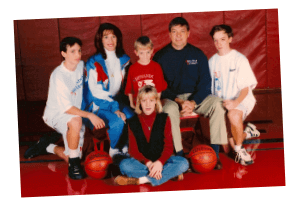
Jeremy Schutt ’01, Baseball, Hall of Fame
I played baseball in junior college before Shenandoah. We played Shenandoah and one of the coaches recruited me. I knew it would be a great fit. It was a smaller school and that appealed to me.
As a student, I really enjoyed the school, particularly because of the class sizes. I got to know the teachers and the rest of the students. I wasn’t just a number. Teachers and professors were always willing to give help whenever I needed it. I have to say, school was not my best area. I liked baseball and school was second. It took me a little time to mature and realize that school was more important. The coaches became mentors and kept me [moving] in the right direction.
As an athlete, it was one of the best experiences of my life. Shenandoah had a good core group of players when I was there. I thought we could have a really good team. We had never been nationally ranked, but I knew we could do something, make some noise in the conference, which we did. We were the first team that was ever nationally ranked. Unfortunately, we lost in the championship. But I still have lifelong friends from that team. And there was so much support from the school and the community. I couldn’t be more proud of what we did.
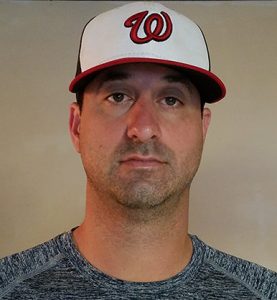 My mother passed away my final year, on Thanksgiving Day. Shenandoah established an annual award in my mother’s name, the Irene Schutt Award for Excellence. It’s given to players that are great teammates and who do things right. And that’s what I’m really most proud of, not my own achievements and game statistics. Not only am I honored, but my mother is honored as well.
My mother passed away my final year, on Thanksgiving Day. Shenandoah established an annual award in my mother’s name, the Irene Schutt Award for Excellence. It’s given to players that are great teammates and who do things right. And that’s what I’m really most proud of, not my own achievements and game statistics. Not only am I honored, but my mother is honored as well.
Jeremy Schutt, 37, is an eighth-grade health and physical education teacher in Fairfax County, Virginia.
Vickie Wright Lord ’90 Basketball, Hall of Fame
A basketball player and friend from my hometown was at Shenandoah. He introduced me to the coach at the time, explained that I was a fairly decent high school player, and that I was a person he might want to consider putting on his team.
When I first entered the college, Shenandoah was working toward becoming a university. When we got our new athletic director, Dave Dutton, he brought with him big expectations and big dreams. He really overhauled the athletic department and gave it a big-time exciting feel. The Dave Dutton era was really the time that Shenandoah athletics took off. He loved to win. He loved to motivate people.
When I played, we had such a diverse team. There was a student from the conservatory. A student from the nursing school. Several in the business school. Several in academic training. Everybody brought a unique twist to the team. But we all had a common ground of wanting to win and working hard. We had great seasons, and it was a great experience.
We also had the winningest season in the college history while I was there. We had multiple players win The President’s Award. We had multiple players score more than 1,000 points. It was a really good era to be in.
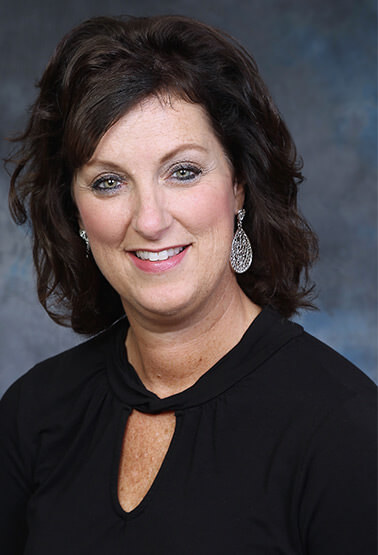 My teammates ended up becoming my lifelong friends. We had such a great group of young ladies back then. We had a ton of fun, but we worked hard and worked hard together to get to where we wanted. That was a great lesson to learn.
My teammates ended up becoming my lifelong friends. We had such a great group of young ladies back then. We had a ton of fun, but we worked hard and worked hard together to get to where we wanted. That was a great lesson to learn.
We always had such great community support. Winchester is a great town. It supports the university, and Shenandoah has grown in leaps and bounds since I graduated. But it’s still small enough where you can get that individualized attention.
I am thrilled to be in the Hall of Fame. But when you play a team sport, it’s not really how you got there but how your team got you there. So that honor is a team honor. I wish I could go back and do it again.
Vickie Wright Lord, 48, is regional director for Valley Health System. She lives in Inwood, West Virginia.
Dick Ward ’52 Basketball, Hall of Fame
The coach of Shenandoah College, and my high school coach were buddies. He called me and said, “I hear you’re a pretty good basketball player. Would you like to come to Shenandoah?” I said, “Sure.”
It was in Dayton, and it was small, but, to me, it was one of the most wonderful places in the whole world. You got to know everybody. It was family all the way down.
We played schools that were bigger than we were, and it didn’t seem to matter a whole lot. Our record was good.
All the players lived in the same dorm. Actually, it was a barracks. We were together all day, every day. None of us had any money, so there wasn’t a whole lot of trouble to get into. The girls had to be in their dorms by nine o’clock, and after nine, Dayton just died. So we went to the gym and played basketball.
We’d play basketball until midnight. We were so close as a group that we knew what the other was going to do on the court. My best buddy, Murrell Bolliger, and me always played each other, and we made each other better.
We weren’t very big, and the odds were against our bunch. But we held our own against any team we ever played. Murrell scored 40 points in one game. I scored 27 points. And that’s without the three-pointer! We had to do a lot of stealing the ball. Our center, who was not that big, was mean enough to steal the ball when we couldn’t get it. We were very well rounded. Skippy Hill was a very good coach. He was the one that made the program go.
Shenandoah Conservatory of Music was part of Shenandoah College. I studied violin, cello and piano. The opportunity was there. It was an opportunity I wouldn’t have had someplace else. It was wonderful. I married a conservatory graduate. She’s been my faithful wife of 52 years.
I think the new athletic center will be fantastic. Things like that attract players. Too bad I’m getting old now or I’d go back and coach. I love that place dearly. It’s not Dayton, but Winchester means as much to me as Dayton.
My whole time at Shenandoah precious to me. I think it was precious to everyone who went to school at Dayton. Sometimes being small is special.
Dick Ward recently finished 52 years of coaching football. He and his wife live in Delaware.
Erin Septer Senior, Soccer
I was playing with a travel team in New Jersey and Coach Pike was at one of our games. She started talking to me and said she liked how I played and would I be interested in coming to Shenandoah. So I took a look at the school, and I liked the program. I liked the campus and the surrounding area. So I decided to come here.
Our team is a close-knit family. We’re very, very close, and e talk to each other all the time, even when we are not in season. We all hang out with each other and enjoy each other’s company.
I love seeing the program grow. We started off strong my freshman year, and we’ve grown stronger ever since. We tied Lynchburg this last season and that was big for us. We set the ODAC winning streak, and we’ve just grown stronger from there. Before last season, we had a chance to go to Spain to play. That really helped us grow into the strong team that we are. And we get a lot of support. The professors come out to our games all the time. They ask how practice is going. They stay tuned to all the athletic news. If someone has a good game, the professors all congratulate us. Being a part of the Shenandoah athletic program has really changed me a lot. It has helped me grow as a person.
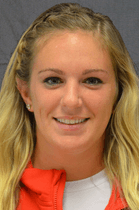 I’m very excited about the new athletic center. For me, getting a new athletic center means our sports are growing for all the 21 teams here. It’s going to be so much fun to see.
I’m very excited about the new athletic center. For me, getting a new athletic center means our sports are growing for all the 21 teams here. It’s going to be so much fun to see.
After graduation, Erin Septer plans a career as an occupational therapist.
Michael McVearry ’05 Football
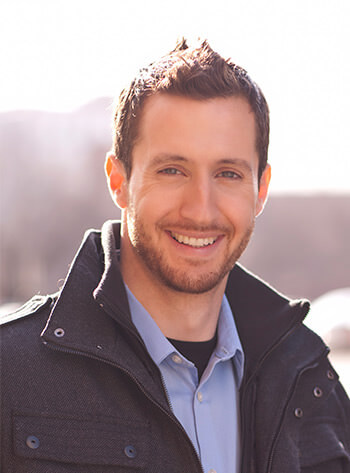 When I was looking for colleges, I liked the idea of a smaller college. You get to know everyone and be a part of the community.
When I was looking for colleges, I liked the idea of a smaller college. You get to know everyone and be a part of the community.
Coach Walter Barr was the head football coach when I was going into my freshman year. Football was just starting up at Shenandoah. I knew a little bit about coach Barr’s background and the success he’d had, which appealed to me. And I really liked the idea of going into a startup program, a situation where you get to build what would be coming historically, to be able to put the foundation down for a school. I wanted to grow with it, and that was one of the things that led me to Shenandoah.
It was a really great experience for me. With a startup program, it’s easy to just assume that you’re at the low end of the totem pole, to not necessarily have the highest of expectations. But it was the complete opposite. Coach Barr brought the mentality of a winning coach, .and, believe me, we were put to the test. It was by far some of the hardest days of camp I ever endured. We were getting up at five in the morning for padded practice. I’d never started the first day of practice in pads until then. Two weeks, three a day, full padded – it was an experience to say the least. But, you can sit there and whine or you can just get going. And when you do this before the season starts, and then you’re playing football and it’s the fourth quarter, you’re not tired. You were tired at five in the morning! So it was great having an old-school, hard-nosed coach like Coach Barr. He taught us a lot of things about perseverance and personality — the way you carry and hold yourself at all times.
We had two championship rings my junior and senior year. It was just great to be a part of it all.
At Shenandoah, I was able to focus myself. I went from not necessarily being the greatest student ever to [making] the dean’s list the last three years I was there. I just needed to be somewhere they took care of me and gave me the individual attention that I needed. I got it at Shenandoah.
When we started the football program, we were playing our home games at Sherando and James Wood high schools. So when the football stadium was built, it was a great pride thing for us. My freshman year we went in and actually put in the seats for the stadium. We literally helped build part of that stadium. That was a great thing for all of us, to be able to go in and put those seats in. And now, when we go back, we can sit down in those seats and feel that we’re still part of the school and the team.
Michael McVearry, 33, currently runs a clothing store and T-shirt company in Maryland.
Bobby Orndorff ’67 Football/Baseball, Hall of Fame
Shenandoah was a junior college when I attended in 1965. We only had about 27 guys on the football team. We started off by losing to Ferrum, who went on to win the national championship that year. That was our first game. They beat us by 35 points or something like that. But, after that, we went on a three-game winning streak and knocked off two nationally ranked teams. So that was very enjoyable. Coach Brown put together a pretty good team.
I was all-conference at quarterback that first year. It was an experience for me going to the next level. We were playing a different brand of football. But if I had to go back and pick a team to play a certain season, it would be the team Mr. Brown put together in ’65. That’s one of my memorable achievements in my sports history.
Shenandoah gave me an education –– not just in athletics, but also in academics. It helped me to focus. The community was very supportive. And it was just an outstanding staff., not just in athletics, but in academics as well. They worked with you and made you feel at home.
I love the brand of football — Division III — that Shenandoah plays. It gives the little man, who is not going to Division I or Division II, a chance. It’s an opportunity to get recognition. And if you get a break, you can move up to the next level. I know of a few who have made it into the pros.
I was born and raised in Winchester. I still live in Winchester. My roots are in Winchester. I was a two-time all regional selection at quarterback in ’65 and ’66. I was also the recipient of the Golden Helmet Award. In 1967, I was the Shenandoah baseball MVP. I appeared in the “Faces In The Crowd” feature in Sports Illustrated. I’ve been very blessed to have the coaches, teachers and teammates that I did.
Bobby Orndorff is a retired educator living in Winchester, Virginia.
Susan Eberly Short ’81 Basketball/Softball, Hall of Fame
I had applied and been accepted at West Virginia University to study music. But I had an aunt who suggested I look at Shenandoah. I’d been to Winchester, and I liked that little town. So I did look at Shenandoah and I applied there.
The day of my scheduled music audition was a day in early April. If you can only imagine how beautiful the Shenandoah campus is in the springtime. It was amazing!
I was a kid from a very rural area in western Maryland and Shenandoah was just a perfect fit for me — from a community perspective and from a learning perspective. It allowed me to entertain the notion of not only majoring in music, but perhaps being able to play a sport.
Shenandoah did not have a women’s basketball program when I arrived there. But unbeknownst to me, Shenandoah was committed to an intercollegiate program, even though there had not yet been any recruitment at that time.
I’ll never forget going to freshman orientation in August of 1977. We were told we would have to report to the gymnasium by alphabetical order for a physical assessment. I remember going down to the gym, and there was this huge line of women spewing out the doors. I said, “What’s this about?” And they said, “They’re having us dribbling a basketball and shooting baskets.” That was the physical assessment! Well, I was the middle child with brothers on both sides, and anything that involved a ball, it didn’t matter if you were a boy or a girl, you just had at it. So I dribbled a little bit and shot some free throws, and Coach Kopp said to me, “Are you the Eberly girl?” I said, “Yeah.” And he said, “We’re starting an intercollegiate program, and I’d like you to think about joining us.” That’s how the first intercollegiate women’s program at Shenandoah was formed. Coach Kopp did an assessment of all the girls and, I’ll tell you what, the 12 to 14 players he pulled together that first year are some of the best athletes I’ve ever been around.
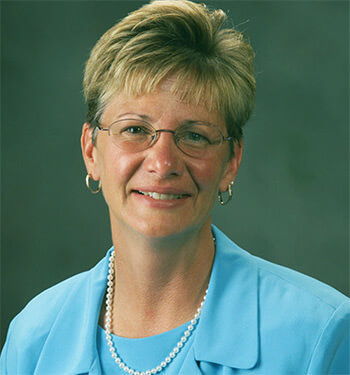 It’s unbelievable now to me to be inducted into Shenandoah’s athletic Hall of Fame. When I got the letter, I thought, “This must be a joke from somebody.” But I guess it helps being the first female 1,000-point scorer, with no three-point line. It’s a distinguished group of athletes, and I am just so proud to be included among them.
It’s unbelievable now to me to be inducted into Shenandoah’s athletic Hall of Fame. When I got the letter, I thought, “This must be a joke from somebody.” But I guess it helps being the first female 1,000-point scorer, with no three-point line. It’s a distinguished group of athletes, and I am just so proud to be included among them.
I loved basketball. It always came easy to me, and I say to this day, of the leadership skills I developed in my 50-some years, many of them came from basketball at Shenandoah. These are the skills of getting along with others and work ethic. There’s nothing like having an opportunity to stand on the free-throw line with your team, down by one, and no time left on the clock! There are a lot of lessons to be learned in athletics. Had I not played ball at Shenandoah, I would not have had this experience.
Susan Eberly Short, 56, is associate vice president for engagement at Virginia Tech. She has also had a 30-year career officiating basketball.
Deanna Estes ’98 Basketball/Lacrosse, Hall of Fame
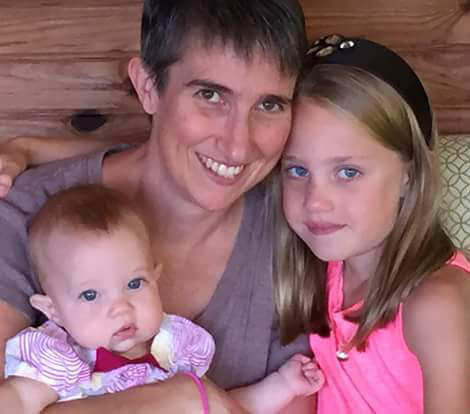
I received a letter from Shenandoah’s head basketball coach when I was a senior in high school. I had been thinking about maybe playing a sport at a Division III school, but nobody had gotten in touch with me. Shenandoah did. I was pretty flattered.
The athletic program at Shenandoah, especially for females, was just getting going. So there was a lot of room for growth. In basketball, I started right away. I got the opportunity to be the floor leader. That was great. The coaches had the confidence in me and let me do what I could do. It was great fun, and we got more competitive as the years went on.
As a student-athlete, I had a fantastic education. I majored in biology, but my concentration was in field biology. I honestly can’t think I would have gotten any better education anywhere else.
Shenandoah didn’t have big-time conference play back in the ’80s, but by the time I got there, we were very competitive. Sure, it was a small gymnasium, our locker room had been an old storage room. It was a small school, but we could compete. By the time I graduated, we were on the map. For a while, the women were a little bit more competitive than the men. Again, by the time I graduated, people were coming to Shenandoah to play from all over Virginia and from Maryland and Pennsylvania.
Our highlight as a team was my sophomore year. We were the bottom seed in the conference, the worst team, so to speak. We went to the conference tournament and had to win three games in three days to win the tournament. We did! And we were playing against the best in the conference. It was a highlight for me personally. I played every minute of all three games. I was named the tournament MVP, and we got to go to the NCAA tournament for the first time in women’s basketball.
The tournament was at Shenandoah. The gym was so small, there weren’t enough seats for everyone. I remember the men’s soccer team lining the in-line of the court in support. Everybody was there to cheer us on. The faculty, too, and the community. There was so much community support for the team. Athletic Director Dave Dutton did a great job reaching out to the community and getting them involved, to support the program and see what we had to offer.
I’m a teacher now, and I credit being an athlete at Shenandoah for the successes I now have in the classroom.
Deanna Estes, 40, teaches earth sciences at Orange County High School in Orange, Virginia.
Walter Barr Coach, Football, 1999-2001
Shenandoah was just starting the football program, and I was the first football coach. Before that, I’d coached at Shepherd College for 15 years. Dr. [James A.] Davis, president of Shenandoah, called me to see if I would be interested in coming to the school and getting the football program off the ground. We did the recruiting in 1999 and started the team in 2000.
It was a startup program, and some of the student-athletes weren’t sure about that, but many felt it was a good thing. They could be in on the ground floor and get to play sooner than if they went to a school with an established program and have to wait their turn. We got a lot of good athletes, about 100 players that wanted to come to Shenandoah.
If you take on a young team, you know you’re going to have your ups and downs. They’ve got to learn where they are, that they’re not back in high school, anymore. That was the most difficult part of starting the program, but it was very exciting. That first year we were four and six, and that wasn’t bad considering we didn’t have a field to practice on or a field to play on. We played on high school fields around the area until we built the stadium.
The special thing was how the school accepted us. Dr. Davis really wanted the football program. The faculty really wanted it, too. Everyone pitched in to try and help us out with all the work that went into developing it. A lot of places want to get rid of football, but Shenandoah wanted football, and they wanted athletes of good character. We tried to get the best we could get, in character and academics. These were good students.
Coaching at Shenandoah was an educational experience…where kids learned to work together, care about each other and care about being successful at what they do. To see the best in each other. To work together as a team. Those are the things they will carry with them for the rest of their lives. Not being an “I” person or a “me” person, but to be a team. That’s what they learned from it.
Walter Barr is retired and lives in Winchester, Virginia.
Donald Wright ’64 Baseball/Basketball, Hall of Fame
I graduated from high school in 1962. I was very athletic and got my share of honors. A lot of schools were recruiting me, but I’d never taken school seriously. I went to school to play sports. So when it turned out schools were interested in me, I didn’t have the academics to get in. I was playing American Legion baseball, and we went to Shenandoah for a game against Winchester. The Shenandoah coaches were there to see somebody else, but they asked me what my intentions were. Well, I said I was open. So I went to Shenandoah.
Shenandoah had only been in Winchester a couple of years. There were four or five buildings and the dorms. We didn’t have a gymnasium. We practiced in an old armory for basketball and played our games at the local high schools. And we did ok. We had a Christmas tournament and went to New York and played. We thought we were big-time.
Baseball-wise, there was a field in front of the armory. We played community colleges or junior colleges. We won our district and got to go to the regional and thought we were hot-shot guys, this bunch of boys.
We weren’t fancy dressed. We just got out and played. You’d go on a road trip and get a dollar a day in meal money, which was a dollar more than I’d ever gotten before. We played hard. We had fun.
A highlight for me was when we won the tri-state conference in baseball, and we got to go to New York to play in the regional tournament. I was MVP and a junior college All-American. Now I’m in the Shenandoah Hall of Fame. Me! This old country boy. I just loved to play. As far as the academics went, the academics at Shenandoah were hard. They made you do the work. I was behind to start off with, but I got caught up.
Shenandoah took a chance on me and hopefully I took advantage of it. I’m always privileged and proud that I went to Shenandoah. For a few years they were going through growing pains, but they are an elite university now. It has provided a stepping-stone for many, many people. A quality stepping-stone.
Donald Wright, 72, played baseball in both the Pittsburgh Pirates and Kansas City Royals minor league systems. He is a retired high school teacher and coach and currently works his farm in the Charlottesville, Virginia area.
David Arehart ’91 Soccer
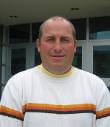 I grew up in Elkton, Maryland. I was involved in soccer since I was a kid and played in high school. Shenandoah reached out to me. I was looking at some other universities, but came out for a visit to Shenandoah and made it my choice.
I grew up in Elkton, Maryland. I was involved in soccer since I was a kid and played in high school. Shenandoah reached out to me. I was looking at some other universities, but came out for a visit to Shenandoah and made it my choice.
We had an outstanding class of individuals that were starting in the program at the same time as I was. I came in with about 10 other guys, and we really got the ball rolling with soccer. The level of competition was great. We were successful and got better each year I was there. It was an awesome thing to be a part of.
We became an active player within our conference. We were able to competitively play with larger schools. As we got older and matured together. We won some great victories. We beat some nationally ranked teams, which I think was probably a first for the university. We let everybody know we were out there to play. I was MVP on my team my sophomore year, which was a great personal honor. But it was about the team, not the personal achievement. It was all about the team.
I hope everyone can be blessed with the experience that I had. Any school where you’re able to get the personal touch is going to be a true benefit. Shenandoah was like that. There’s a consideration overall for your well-being. At Shenandoah there’s a focus on how to be successful academically, and that comes into focus after you mature a bit and realize there is going to be a life after you play a sport in college.
Shenandoah is where it started for me.
David Arehart, 49, is a golf professional and PGA member. He is head golf professional and coach at Delhi College in New York.
Greg Van Sickler ’11 Baseball
Coach [Kevin] Anderson came to my high school in my hometown of Winchester. He gave a presentation about Shenandoah. He’s a mammoth of a man, so you can’t miss him when he’s speaking. He had such passion for the Shenandoah and such passion for the game of baseball. It seemed like a good fit for me.
I wanted a business school and a small university [experience]. I didn’t want to feel like just a number, and I wanted to keep playing baseball. I wasn’t quite good enough out of high school to play Division I, just a scrawny kid. And Shenandoah was a great opportunity for me to continue playing, to get a degree to prepare for a career when baseball ended. I was very fortunate to end up there.
Going to the [Division III] World Series twice was just an unbelievable experience. And I played for the greatest coach I’ve ever played for in my life. There was such camaraderie. I still keep in touch with a lot of my teammates from the college days. In my sophomore year, I won the ODAC pitcher and player of the year awards. It was humbling and, really, hats off to my coaches. They really helped transform me into a much better player coming from high school and helped me to have more success in my later years at college.
I grew tremendously there. Through athletics I grew as a person. I did a lot of things wrong as a player in high school and was very fortunate to have the right nucleus of coaches around me to recognize the problems, fix them, and put me in the best position for success. I’m extremely thankful for that. I wouldn’t have figured it out on my own.
I’m thrilled at the idea of the new athletic center. It means the world to me as an alumnus, that all of our sacrifice and hard work throughout the years — the sports teams across the board — have paved the way for something wonderful like this.
To have a great education. To have a fantastic career in athletics. And to be given the opportunity to continue. That’s what Shenandoah did for me.
Greg Van Sickler, 27, lives in Houston, Texas, and currently works in the front office for the Houston Astros.
Robert Kulton ’91 Soccer, and Soccer/Golf Coach, 1989-2006
My high school coach lived in Marshall, Virginia, and wasn’t far from Shenandoah. He had recently come across the new soccer program there and said to me, “Hey, this might be a place you want to look at.”
I have to say, Shenandoah was not my first choice, but I met with the coach and the next thing I knew, everything was done. It turned out to be a great decision for me.
My first year was the first year we were a varsity sport. We only had a roster of about 12 or 13 players. So my experience that first year was to play every minute. I didn’t come off the field. I can remember playing a game with Randolph-Macon where it was 103 degrees in the shade, and we had no subs. It was definitely trial by fire that first year, but by my sophomore year, we had the talent to compete with just about anyone.
My teammates and I instantly became brothers. We’re still very close, and that really was the foundation for how the program grew, because all of us stayed and played a minimum of three years. We literally built that program because that class stayed all the way through.
Really, it all started at the top with Dr. Davis. I don’t remember too many games where he wasn’t at the match. The leadership was behind us. He was a fan of the sport, and he was adamant that he wanted to see the sport grow at Shenandoah. And through his commitment, the sport did grow.
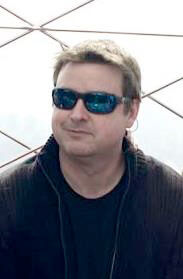 My senior year, they decided they wanted to add women’s soccer as a program. The next year, they did. I was a four-year captain, and I had become very close to Coach Smith. He asked me to stay on and be his assistant. For me, it was an easy decision. When the women’s program started, I became coach for the women and assistant coach for the men. Later, I was also the assistant tennis coach. I was sports information director for two years. When they decided to try and grow the golf program, they offered me the opportunity to coach soccer and golf together, and that’s what I ultimately did.
My senior year, they decided they wanted to add women’s soccer as a program. The next year, they did. I was a four-year captain, and I had become very close to Coach Smith. He asked me to stay on and be his assistant. For me, it was an easy decision. When the women’s program started, I became coach for the women and assistant coach for the men. Later, I was also the assistant tennis coach. I was sports information director for two years. When they decided to try and grow the golf program, they offered me the opportunity to coach soccer and golf together, and that’s what I ultimately did.
In my 17 years as a coach and my four years as a player, I saw Shenandoah athletics evolve from a very small program of basketball, golf, baseball and soccer to a university with a multitude of sports.
The keys for me were the people I was associated with. Dave Dutton, brought a vision. His vision of, “Can we make a Division III school be like a Division I with the right quality of life that a small school provides?” That was always his approach. Along with President Davis, these two men were really the key to my success and the foundation for what Shenandoah stands on today.
Robert Kulton, 50, is a director of business development and lives in Winchester, Virginia.
